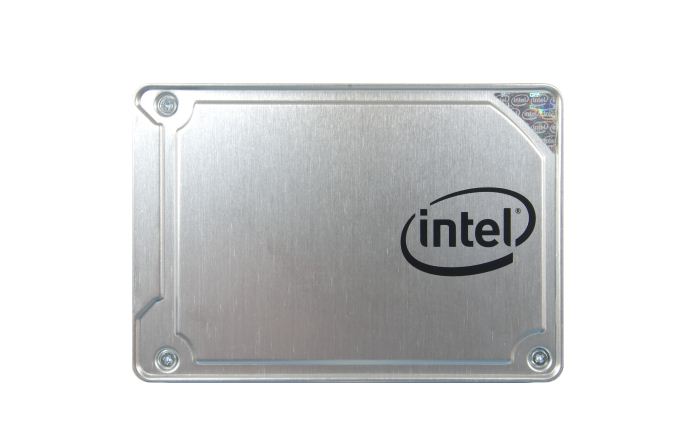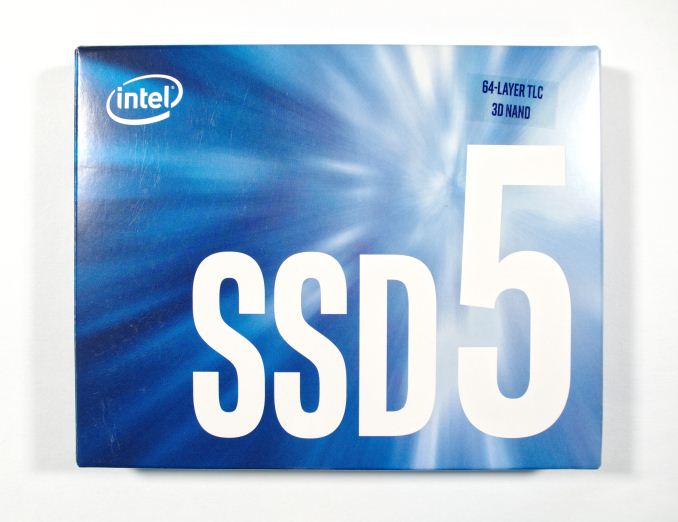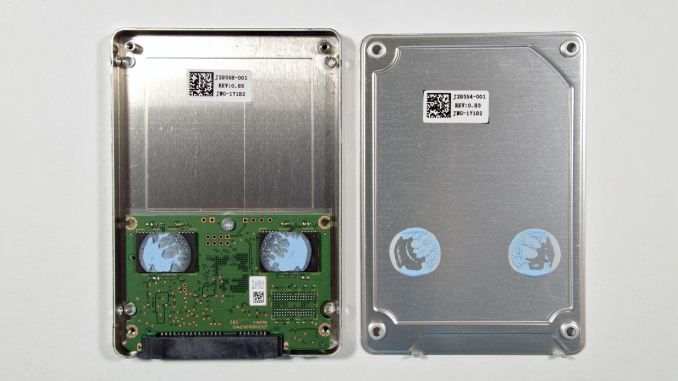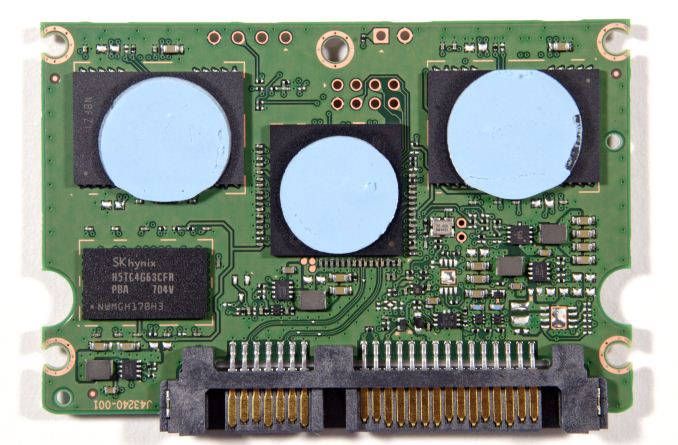The Intel SSD 545s (512GB) Review: 64-Layer 3D TLC NAND Hits Retail
by Billy Tallis on June 27, 2017 6:00 AM EST
Today Intel is introducing their SSD 545s, the first product with their new 64-layer 3D NAND flash memory and, in a move that gives Intel a little bit of bragging rights, the first SSD on the market to use 64-layer 3D NAND from any manufacturer.
The Intel SSD 545s is a mainstream consumer SSD, which these days means it's using the SATA interface and TLC NAND flash. The 545s is the successor to last year's Intel SSD 540s, which was in many ways a filler product to cover up inconvenient gaps in Intel's SSD technology roadmap. When the 540s launched, Intel's first generation of 3D NAND was not quite ready, and Intel had no cost-competitive planar NAND of their own due to skipping the 16nm node at IMFT. This forced Intel to use 16nm TLC from SK Hynix in the 540s. Less unusual for Intel, the 540s also used a third-party SSD controller: Silicon Motion's SM2258. Silicon Motion's SSD controllers are seldom the fastest, but performance is usually decent and the cost is low. Intel's in-house SATA SSD controllers were enterprise-focused and not ready to compete in the new TLC-based consumer market.
The Intel SSD 545s continues Intel's close relationship with Silicon Motion by being one of the first SSDs to use the latest SM2259 controller. Since the SATA interface is now a dead-end technology, the SM2259 is a fairly minor update over the SM2258 controller used by last year's Intel SSD 540s. The only significant new feature enabled by the updated controller is hardware end-to-end data protection that includes ECC on the controller's SRAM and on the external DRAM. This will make the 545s more resilient against corruption of in-flight data, but it should not be mistaken for the power loss protection that is typically found on enterprise SSDs.
The flash memory used in the Intel 545s is Intel's second generation 3D TLC NAND, a 64-layer design with a floating gate memory cell. Intel did not use their first-generation 32-layer 3D NAND in a consumer SATA SSD, but the 32L 3D TLC is at the heart of Intel's SSD 600p, their first M.2 NVMe SSD and one of the most affordable consumer NVMe SSDs.
Similar to the strategy Micron used last year when introducing the Crucial MX300, the Intel 545s initially brings a new generation of 3D NAND to the market with just a single SKU. The 512GB 545s is available now on Newegg, with other capacities and the M.2 SATA versions to follow over the next few weeks. The full lineup will include capacities from 128GB to 2TB in both 2.5" and M.2 form factors.
Intel will be using their smaller 256Gb 64L TLC die for all capacities of the 545s, rather than adopting the 512Gb 64L TLC part for the larger models. The 512Gb die is not yet in volume production and Intel plans to have the full range of 545s models on the market before the 512Gb parts are available in volume. Once the 512Gb parts are available we can expect to seem them used in other product families to enable even higher drive capacities, but it is reassuring to see Intel choosing the performance advantages of smaller more numerous dies for the mainstream consumer product range.
Meanwhile, over the rest of this year, Intel plans to incorporate 64L 3D NAND into SSDs in every product segment. Most of those products are still under wraps, but the Pro 5450s and E 5100s are on the way as the OEM and embedded versions of the 545s.
Intel seems to be in a hurry to get this drive out the door so they can claim to be the first shipping SSDs with 64-layer 3D NAND. At Computex we saw Western Digital announce their first 64L 3D NAND SSDs due to be available in Q3, and Toshiba is already sampling the XG5 M.2 NVMe SSD to OEMs. Earlier this month, Samsung announced the start of volume production of their 64-layer 256Gb V-NAND. By launching with retail availability this week, Intel has narrowly secured first place bragging rights. (It seems Intel and Micron might have an agreement to take turns introducing new 3D NAND, given that Micron was first to ship the 32L 3D NAND last year with the Crucial MX300.)
The downside is that this is a rushed launch; I've had the drive in hand for less than five days as of publication time, and that time spanned a weekend. Intel's press briefing on this drive was a mere fifteen hours before the embargo lift, and the slides included some changed specifications relative to the product brief that was delivered with the drive last week. As with several of their recent SSD launches, Intel is only providing the one-page product brief and is withholding the full specifications document from the general public and the press, but this time it might genuinely be due to the latter document not being ready instead of motivated by the questionable IP security concerns Intel cited earlier this year.
| Intel SSD 545s Specifications Comparison | |||
| Model | 545s 512GB | 540s 480GB | |
| Controller | Silicon Motion SM2259 | Silicon Motion SM2258 | |
| NAND Flash | Intel 256Gb 64-layer 3D TLC | SK Hynix 16nm TLC | |
| Sequential Read | 550 MB/s | 560 MB/s | |
| Sequential Write | Burst | 500 MB/s | 480 MB/s |
| Sustained | 475 MB/s | 40 MB/s | |
| Random Read IOPS | 75k | 78k | |
| Random Write IOPS | 90k | 85k | |
| TCG Opal Encryption | No | No | |
| Power Management | Slumber and DevSleep | Slumber and DevSleep | |
| Form Factor | 2.5" 7mm (M.2 later this year) | 2.5" 7mm and M.2 2280 | |
| Write Endurance | 288 TB (0.3 DWPD) | ||
| Warranty | 5 years | 5 years | |
| Launch MSRP | $179 | $174 | |
The most significant performance improvement Intel cites for the 545s over the 540s is in sustained sequential transfers where writes exceed the size of the drive's SLC cache. In the briefing for the 545s Intel claimed the 480GB 540s would drop to 40MB/s while the 512GB 545s is capable of maintaining 475MB/s. The numbers given for the 540s are lower than what the full product specifications from last year list (125 MB/s). Without access to the comparable document for the 545s we can't entirely explain this discrepancy, but the most plausible reason is that Intel is no longer measuring sustained write speed restricted to an 8GB span of the drive and that they are now instead using a more sensible test where the drive is full or nearly so. Either way, the 545s should be able to perform much better after its SLC cache is full.
Externally, the 545s looks like a typical Intel SATA SSD with only minor design variations. Internally, the density of Intel's 3D NAND is readily apparent from the PCB that occupies less than half of the case and features only four NAND packages. With 256Gb (32GB) per die, this works out to four dies per package. Even the largest 2TB model should be able to use this PCB with sixteen dies per package and populating the empty pad for a second DRAM package. The Intel SSD 545s uses thermal pads on all four NAND packages and on the controller.
The 512GB Intel 545s debuts with a MSRP of $179. This is slightly higher than the launch MSRP of $174 for the 480GB Intel 540s, but on a price per GB basis the 545s is cheaper, and since its launch the MSRP of the 540s has been driven up to $189 by the onset of an industry-wide NAND flash shortage. In this narrow context the MSRP for the 545s may seem reasonable, but its true street price will need to be substantially lower. Intel's 600p NVMe SSD is currently only $175 on Newegg. Since the 600p outperforms any SATA SSD for typical real-world desktop use, the 545s needs to do better than 35¢/GB. The competition based on Micron's 32L 3D TLC includes the Crucial MX300 for around 30¢/GB, and the Samsung 850 EVO 500GB happens to be on sale on Newegg today for $165 (33¢/GB).
This launch comes at a bit of an awkward time for us. I've retired our aging 2015 SSD testbed and moved all the custom and homemade power measurement equipment over to a new system. Windows 8.1 is out and Windows 10 is in, and our IOmeter synthetic benchmarks are being replaced with Linux-based FIO tests that are more suited to modern TLC SSDs with SLC caches. For the past few weeks I've been focusing my efforts on validating the new testbed and test suite against NVMe SSDs, so the arrival at short notice of a new SATA SSD left me with no relevant comparison data. Given the time available, I chose to prioritize the benchmarks that are most relevant to real-world usage and to run a small selection of competing drives through those tests. This review will be updated with more benchmarks as the drives complete them, and the new SSD 2017 section of our Bench database will be going live soon and will be populated with results from the dozens of drives in our back catalog over the coming weeks.
For now, this review includes our three AnandTech Storage Bench (ATSB) workloads run on the new testbed, SYSmark 2014 SE and idle power management tests. The Intel SSD 545s is pitted against its predecessor the Intel SSD 540s, and most of the SATA SSDs with 3D NAND that have been on the market: Samsung's 850 EVO and 850 PRO, the Crucial MX300 and the ADATA Ultimate SU800.
| AnandTech 2017 SSD Testbed | |
| CPU | Intel Xeon E3 1240 v5 |
| Motherboard | ASRock Fatal1ty E3V5 Performance Gaming/OC |
| Chipset | Intel C232 |
| Memory | 4x 8GB G.SKILL Ripjaws DDR4-2400 CL15 |
| Graphics | AMD Radeon HD 5450, 1920x1200@60Hz |
| OS | Windows 10 x64, version 1703 |
- Thanks to Intel for the Xeon E3 1240 v5 CPU
- Thanks to ASRock for the E3V5 Performance Gaming/OC
- Thanks to G.SKILL for the Ripjaws DDR4-2400 RAM
- Thanks to Corsair for the RM750 power supply, Carbide 200R case, and Hydro H60 CPU cooler













74 Comments
View All Comments
ddriver - Tuesday, June 27, 2017 - link
Actually yes. Way to go intel...anactoraaron - Tuesday, June 27, 2017 - link
What's wrong with the 600p? You can get the 512gb from newegg for $179, which make me question the 545s price point. If you aren't limited to sata, the 600p 512gb makes much more sense.ddriver - Tuesday, June 27, 2017 - link
"What's wrong with the 600p? "Nothing, aside from the fact it is THE lousiest NVME SSD in the known universe...
Drumsticks - Tuesday, June 27, 2017 - link
Good thing it generally sells at SATA prices then...junky77 - Wednesday, June 28, 2017 - link
It's really not even as fast as SATA SSDs in many tests (I'm talking midrange SSDs, nothing fancy)kaidenshi - Wednesday, June 28, 2017 - link
I've seen a ton of hate for the 600p here, and I can only conclude that I got extremely lucky with mine and ended up with a fluke. Mine has been hands down the fastest SSD I've ever had, and even paired with a bargain-basement Pentium G4500 CPU, it makes everything on my PC feel instant.Perhaps it is the slowest NVMe SSD one can buy, but it is much, much faster than any SATA SSD I've had in this machine. It definitely blows the doors off the 850 Evo, despite claims I've seen here that it's slower. The results on this site mirror what I've seen in my own testing. Basically, the Samsung beats the Intel on random reads only, but loses spectacularly on all other metrics.
http://ssd.userbenchmark.com/Compare/Samsung-850-E...
Samus - Thursday, June 29, 2017 - link
It isn't a speed demon, but it isn't slow either. It's just what you'd expect for the price.And it's sequential transfer rates are substantially faster than anything SATA, so that is the icing on the cake for an SSD that sells for SATA prices.
And being Intel, I expect it will be ultimately more reliable than a similar priced product form ADATA, etc.
alpha754293 - Thursday, June 29, 2017 - link
What's wrong with the Intel 750 series PCIe NVMe SSDs?futrtrubl - Tuesday, June 27, 2017 - link
I'm going to assume the sustained sequential write speed of 40MB/s is a typo.futrtrubl - Tuesday, June 27, 2017 - link
Oh wow, I see it is not.